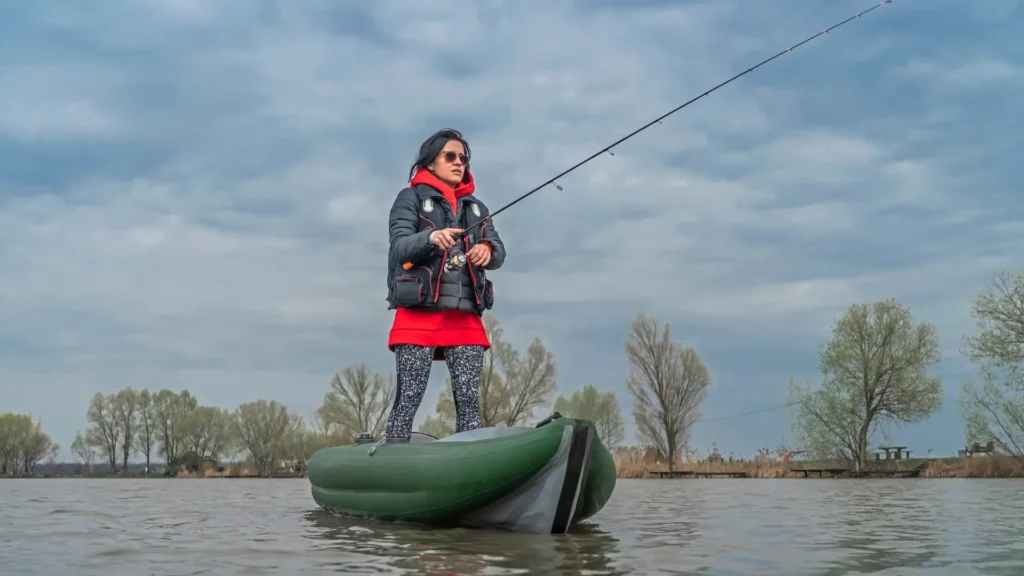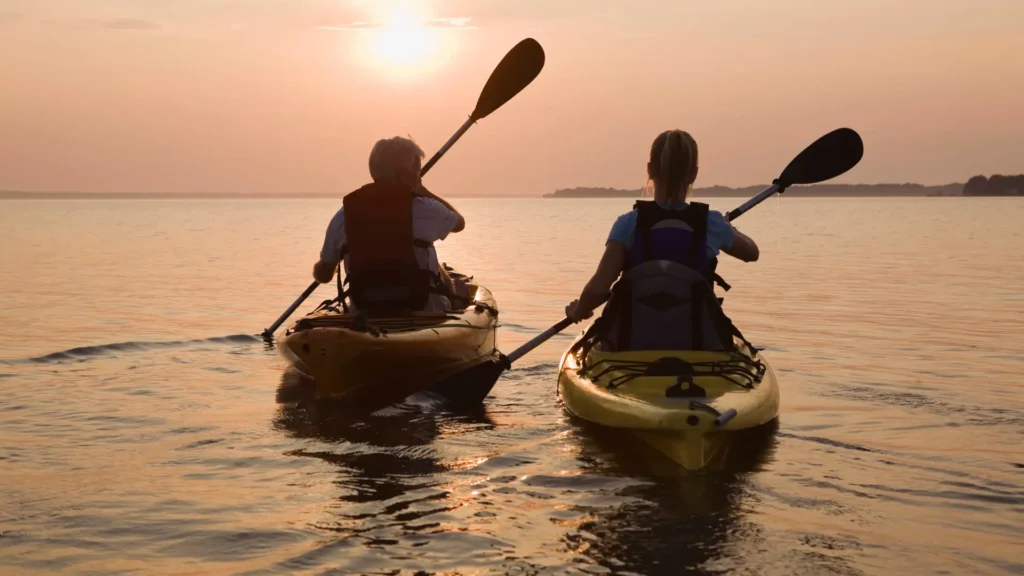(Photo from Kindel Media | pexels.com)
Embarking on open waters can be both exhilarating and daunting for kayak aficionados. Amidst the vastness, trolling emerges as a prime technique. This involves trailing bait or lures behind a moving kayak. For many, it’s the go-to method when aiming for prized catches like salmon and tuna. However, success in this endeavor goes beyond just having the right gear.
Strategy is paramount. Understanding the habits and preferences of these fish species is crucial. Moreover, marine conditions are ever-changing. As such, adaptability becomes a key asset. Whether it’s adjusting trolling speeds or altering lure presentations, flexibility often dictates success. Thus, let’s explore the intricacies of trolling tactics tailored for salmon and tuna pursuits in the realm of open-water kayak fishing.
Gear and Equipment Essentials for Trolling
In the realm of open-water kayak fishing, the right gear can significantly amplify your chances of success. Starting with the basics, a sturdy kayak with ample storage is non-negotiable. Given the potential size and strength of salmon and tuna, ensure your kayak is equipped with a robust rod holder, enabling smooth trolling without compromising maneuverability. Furthermore, investing in a quality fish finder can be a game-changer. This tool offers real-time insights into underwater topography and fish activity, guiding your trolling paths effectively.
Transitioning to the actual fishing gear, your rod and reel setup should be tailored to handle the weight and power of these formidable species. Opt for a medium-heavy to heavy-action rod paired with a high-quality reel, ensuring smooth drag and retrieval. Additionally, your fishing line plays a pivotal role. Braided lines, known for their strength and minimal stretch, are ideal for trolling, offering better sensitivity and control. Always carry a diverse range of lures and bait options. While certain designs might be effective on one day, the next outing might demand a different approach.
Maintenance and Safety: Prioritizing Your Well-being:
Beyond the thrill of the catch, safety remains paramount in open-water kayak fishing. Before embarking on any expedition, conduct a thorough check of your equipment. Ensure your kayak’s hull is free from cracks, and all accessories are securely fastened. Familiarize yourself with basic safety protocols, including how to handle strong currents or unexpected weather changes. Always wear a reliable personal flotation device (PFD) and consider investing in a marine radio for communication purposes.
Moreover, environmental conservation should be at the forefront of every angler’s mind. Respect catch limits and size regulations to ensure sustainable fishing practices. Engage with local fishing communities or organizations to stay updated on conservation efforts and guidelines. Ultimately, while the allure of catching salmon and tuna is undeniable, it’s essential to approach the activity with respect for nature and a commitment to preserving its beauty for future generations.
Adapting to Changing Conditions: Weather and Water Dynamics
In the expanse of open waters, kayak anglers frequently encounter ever-changing conditions that demand adaptability and foresight. One of the most influential factors is the weather. While a sunny day might seem ideal for kayak fishing, it’s essential to monitor wind patterns. Strong winds can create challenging water currents, affecting both your kayak’s stability and trolling efficiency. Therefore, always check weather forecasts beforehand and be prepared with appropriate gear, such as a drift chute or sea anchor, to maintain control during windy conditions.
Additionally, understanding water dynamics is crucial. Currents, influenced by tides and underwater topography, can significantly impact your trolling experience. Familiarize yourself with tidal charts and local current patterns. For instance, certain areas might experience stronger currents during specific times of the day, affecting lure depth and presentation. By studying these patterns, you can strategically position your kayak, ensuring your lure remains in the strike zone longer.
Moreover, consider the seasonality aspect. Open water trolling for salmon and tuna can vary drastically depending on the time of year. During spawning seasons, fish behavior might change, with certain species becoming more territorial or aggressive. Stay informed about seasonal fish movements and adjust your trolling tactics accordingly. Ultimately, while open-water kayak fishing offers unparalleled excitement, mastering the intricacies of weather and water dynamics ensures a safer and more productive angling experience.
Environmental Stewardship: Preserving the Open Water Habitat
Beyond the thrill of the catch, responsible kayak anglers recognize their role as stewards of the marine environment. Open waters, with their delicate ecosystems, require the utmost respect and conservation efforts to ensure sustainability for future generations. Engaging in sustainable fishing practices not only benefits the marine habitat but also enhances the overall kayak fishing experience.
Firstly, always adhere to catch limits and size regulations set by local authorities. Overfishing can disrupt the natural balance of marine ecosystems, impacting not just target species like salmon and tuna but also their prey and associated marine life. By practicing catch-and-release or limiting your catch to sustainable levels, you contribute to the long-term health of the aquatic environment.
Moreover, be mindful of your waste. Dispose of any trash, especially non-biodegradable items, properly. Consider participating in or organizing kayak fishing cleanup events, where enthusiasts come together to remove litter and debris from water bodies. Additionally, avoid anchoring or dragging gear over sensitive marine habitats like coral reefs or seagrass beds. By minimizing your ecological footprint, you play a pivotal role in preserving the pristine beauty and biodiversity of open-water habitats for future kayak fishing adventures.
Trolling Tactics: Deep Diving into Techniques and Approaches
In the intricate dance of open-water kayak fishing, the art of trolling stands out as a versatile and effective technique. However, it’s not just about trailing a bait or lure; it’s about mastering the nuances of presentation, depth, and timing. Delving into specific trolling techniques tailored for salmon and tuna can significantly elevate your kayak fishing game.
Start by mastering the depth at which you present your lure. Both salmon and tuna have specific depth preferences based on factors like water temperature and available prey. Utilize tools like downriggers or diving planers to precisely control lure depth, ensuring you’re in the strike zone. Additionally, experiment with various trolling patterns. For instance, the “S-pattern” mimics the erratic movement of injured prey, often triggering predatory instincts in these fish.
Another crucial aspect is lure action and vibration. Certain lures, designed with built-in actions or rattling chambers, can emit vibrations that resonate with salmon and tuna’s sensory systems. Such lures not only attract fish from a distance but also incite aggressive strikes. Always keep an assortment of lures in your tackle box, ranging from surface poppers to deep-diving plugs, to adapt to changing fish behaviors and preferences.
Joining Kayak Fishing Communities: Learning and Networking
The world of kayak fishing is vast and varied, with numerous nuances and regional insights waiting to be discovered. Engaging with fellow enthusiasts through online forums, local clubs, or social media groups can be immensely beneficial. These platforms offer a wealth of knowledge, from firsthand fishing reports to gear recommendations tailored for specific regions or species.
Furthermore, consider attending kayak fishing workshops or seminars. Such events provide opportunities to learn from seasoned anglers, industry experts, and even marine biologists. Workshops often cover a range of topics, from advanced trolling techniques to marine conservation practices. Additionally, participating in group kayak fishing outings can be both educational and rewarding, offering a chance to observe different tactics and approaches in action.
Moreover, networking within the kayak fishing community can open doors to unique opportunities. From organizing group expeditions to remote fishing spots to collaborating on conservation initiatives, the connections you forge can enrich your kayak fishing journey in myriad ways. Remember, while individual experiences are invaluable, the collective wisdom of a community can propel your skills and understanding to new heights.
Conclusion: The Endless Journey of Kayak Fishing Mastery
(Photo from Nihat | pexels.com)
Open-water kayak fishing, with its blend of excitement, challenge, and connection to nature, is a pursuit that offers endless learning and growth opportunities. From mastering the art of trolling for salmon and tuna to fostering a deep respect for the marine environment, each expedition contributes to your journey as an angler and steward of the sea.
As you continue to explore and evolve, remember to cherish the moments of tranquility, the adrenaline-pumping strikes, and the camaraderie shared with fellow kayak anglers. Embrace the challenges, celebrate the victories, and always strive to deepen your understanding of the intricate dance between predator and prey in the vast expanse of open waters.
Short Tips For Open-Water Kayak Fishing
1 Stay Informed: Regularly check weather forecasts and marine advisories before heading out.
2. Safety First: Always wear your personal flotation device (PFD) and carry essential signaling devices.
3. Respect Nature: Adhere to catch limits and practice responsible catch-and-release methods.
4. Network and Learn: Engage with kayak fishing communities for shared insights and experiences.
5. Embrace Adaptability: Be ready to adjust your tactics based on changing fish behavior and environmental conditions.
Additional Resources:
1. Kayak fishing game – https://store.steampowered.com/app/591986/Fishing_Planet_Kayaks_Adventure_Pack/
2. Seasonal fish movements – https://anglingbuzz.com/2021/06/02/seasonal-fish-movements/
3. Weather forecast – https://www.accuweather.com/
4. Personal Flotation Device (PFD) – https://www.precision-performance.com/blog/5-types-of-pfds-personal-flotation-devices–23269
5. Trolling speeds or altering lure presentations – https://www.floridasportsman.com/editorial/trolling-speed-and-bait-position/397015
Check out our latest blog on 9 Kayak Fishing Mistakes (Don’t Make These!)


